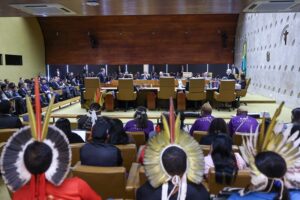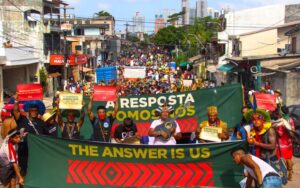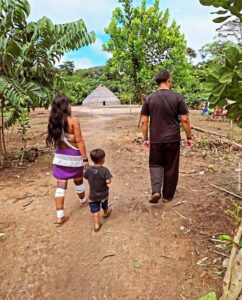The demarcation of the territory of the Munduruku people was paralysed for years because of the São Luiz do Tapajós hydroelectric dam project.
Justice Minister Ricardo Lewandowski signed the declaratory decree delimiting the boundaries of the Sawre Muybu Indigenous Land, in the Tapajós river basin in Pará, with 178,173 hectares. The Munduruku people had been waiting 17 years for this decision, but the process had been paralysed for years because of the São Luiz do Tapajós hydroelectric dam project. From now on, demarcation proper begins, with the establishment of physical landmarks and the removal of occupants for the subsequent ratification of the territory by the president.
The process of demarcating Sawre Muybu, located between the municipalities of Itaituba and Trairão, began in 2007 and, after the anthropological study to identify and delimit the area, was halted by political pressure. The Munduruku even carried out the 'self demarcation' of their territory, expelling invaders and setting up signs to protect it. At the time, Dilma Rousseff's government was planning to build a large dam inside the Indigenous Land, the São Luiz do Tapajós dam. In 2016, the dam project was shelved by the National Foundation for Indigenous Peoples (FUNAI) on the grounds that it was unconstitutional.
Recently, Eletrobrás requested and the National Electric Energy Agency (Aneel) authorised the resumption of studies for the hydroelectric project, which would directly affect the existence of the Sawre Muybu Indigenous Land. It is also among those affected by the Ferrogrão project, a proposed railway for freight that is being planned without any consultation with the indigenous peoples affected.
The declaratory decree for Sawre Muybu is the fourth to be signed by the Ministry of Justice in 2024. Three other indigenous lands had their boundaries declared at the beginning of September, all in the region of the Tapajós basin, between Pará and Mato Grosso. Maró, Cobra Grande and Apiaká do Pontal e Isolados were delimitadas oficialmente em 5 de setembro.
The declaratory decree is one of the fundamental stages of the indigenous land demarcation process, which defines the boundaries of territories after the adversarial phase, when there are no more administrative or judicial disputes. The signing of the declaratory ordinances is a positive sign from the executive branch at a time when indigenous territorial rights are threatened by the conciliation process of Judge Gilmar Mendes in the Supreme Court (STF) and by Law 14,701, which instituted the Marco Temporal already declared unconstitutional by the STF itself.
* The Marco Temporal - efers to the legal theory according to which the original/indigenous peoples can only demand the demarcation of lands where they were already living on October 5, 1988, the date Brazil’s present Federal Constitution was enacted.




